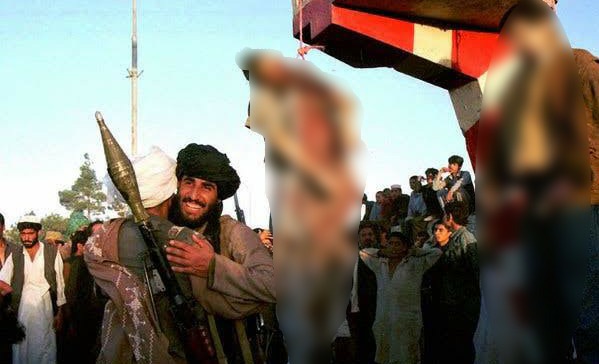Taliban Brutality and Death of Mohammad Najibullah in 1996
Najibullah and his brother were tortured, dragged behind a vehicle, castrated, shot, and hanged from a traffic light post outside the Presidential Palace.
Mohammad Najibullah Ahmadzai, also known as Najibullah, was an Afghan politician serving as the General Secretary of the People’s Democratic Party of Afghanistan, the leader of the one-party ruling Democratic Republic of Afghanistan from 1986 to 1992, and the President of Afghanistan from 1987 till his resignation in April 1992, shortly before the Mujahideen took over Kabul.
His terrible execution at the hands of the Taliban stands right at the top of Afghanistan’s book of tragedies, the grisly opening scene of the Taliban’s five-year reign over the country.
Najibullah, while a medical student in Kabul, joined the communist People’s Democratic Party of Afghanistan, a faction of which staged the violent coup against Afghanistan’s first president, Mohammed Daoud Khan, in April 1978. Daoud Khan was murdered with his children, grandkids, and wife, in a way eerily identical to how the Afghan communists’ ideological forefathers, the Bolsheviks, murdered the Russian royal family six decades before.
Afghanistan was thrown into a spiral of war and strife as a result of the coup, and it is still suffering as a result of it.
Najibullah was a low-profile official after the Saur Revolution and the formation of the Democratic Republic of Afghanistan: he was sent into exile as Ambassador to Iran following Hafizullah Amin’s ascent to power. Following the Soviet invasion that overthrew Amin’s authority and established Babrak Karmal as head of state, party, and government, he returned to Afghanistan.
During Karmal’s reign, Najibullah was appointed chief of the KHAD, Afghanistan’s version of the Soviet KGB. He belonged to the Parcham group, which was commanded by Karmal. During Najibullah’s time as KHAD chief, the organisation became one of the most ruthlessly effective government agencies. Najibullah was appointed to the PDPA Politburo in 1981. Najibullah resigned as state security minister in 1985 to concentrate on PDPA politics; he had been assigned to the PDPA Secretariat. In 1986, Soviet General Secretary Mikhail Gorbachev, also the final Soviet leader, was able to persuade Karmal to resign as PDPA General Secretary and was replaced by Najibullah.
From the time he was appointed as President by Moscow in 1987, Najibullah launched the National Reconciliation Policy, which aimed to bring the country back to peace (NRP). The Soviet Union was undergoing a period of glasnost, and the Red Army’s prolonged presence in Afghanistan appeared to be untenable. Najibullah realised that it wouldn’t be long until he was on his own.
Throughout his presidency, he attempted to gain support for his administration through the National Reconciliation policies, which included abandoning socialism in favour of Afghan nationalism, dissolving the one-party state, and allowing non-communists to join the government. He remained open to talks with the mujahideen and other organisations, proclaimed Islam the official religion, and encouraged exiled businessmen to return and reclaim their properties.
Support Independent Journalism? Keep us live.
Najibullah was left without foreign help following the August Coup in Moscow and the collapse of the Soviet Union in December 1991. This, along with the internal breakdown of his administration (due to the defection of general Abdul Rashid Dostum), resulted in his resignation in April 1992.
The Taliban, who took over Kabul as the capital in September 1996, murdered him and brutalised his body in full front of the international media.
He had resigned after the mujahideen took over Kabul in 1992. In April, India attempted to evacuate him from Afghanistan in a failed mission. The car in which he was being driven to the airport was halted outside the airport gates by guards loyal to Abdul Rashid Dostum, a warlord who had been financed by Najibullah but had changed allegiances when the transactions ceased, after the Afghan government’s tap ran dry following the Soviet Union’s breakup in 1991.
The jet that was supposed to carry Najibullah to Delhi was parked on the runway, and the UN ambassador to Kabul was inside. Najibullah got into a furious debate with the guards, but he was unable to persuade them to let him pass. He couldn’t even return to the President’s mansion. So the vehicle drove him to the UN complex, where he would dwell in self-imprisonment for the next four and a half years.
After a four-year civil war, the Taliban took over Afghanistan from competing groups of the mujahideen. They took Kabul from Ahmad Shah Massoud’s fleeing forces in 1996. Najibullah, his brother, and two other acquaintances who had been hiding at the UN complex were abandoned.
With no UN officials remaining in the complex, a small Taliban team surged in, including, according to some reports, an ISI officer disguised. Najibullah and his brother were tortured, dragged behind a vehicle, castrated, shot, and hanged from a traffic light post outside the Presidential Palace.
The news of Najibullah’s assassination drew significant international criticism, particularly from Muslims. The United Nations released a statement condemning Najibullah’s assassination and claiming that it will further destabilise Afghanistan. The Taliban retaliated by executing Dostum, Massoud, and Burhanuddin Rabbani.
India, which had previously supported Najibullah, vehemently condemned his execution and began to back Massoud’s United Front/Northern Alliance in an effort to curb the Taliban’s growth.


Comments are closed.